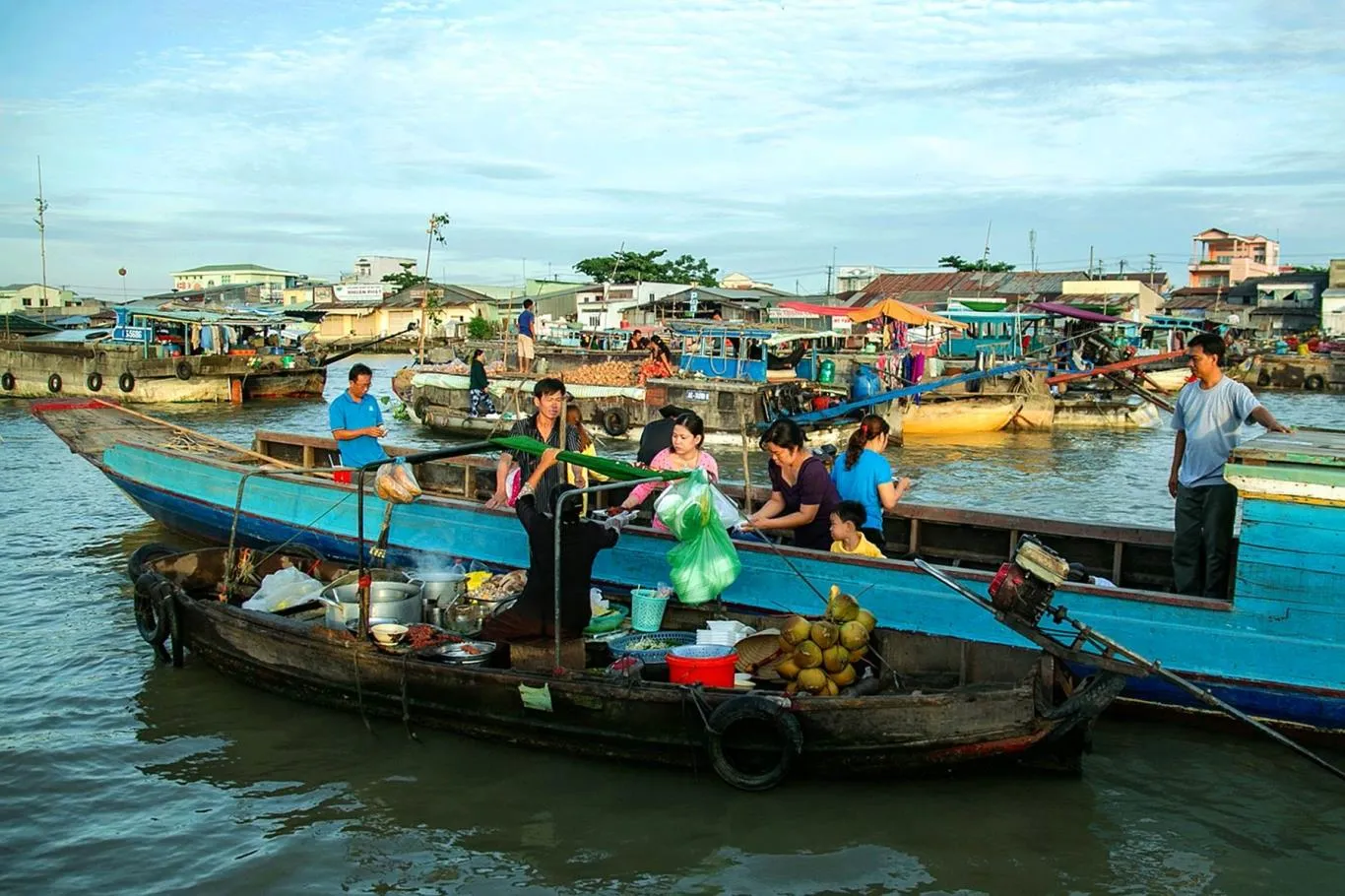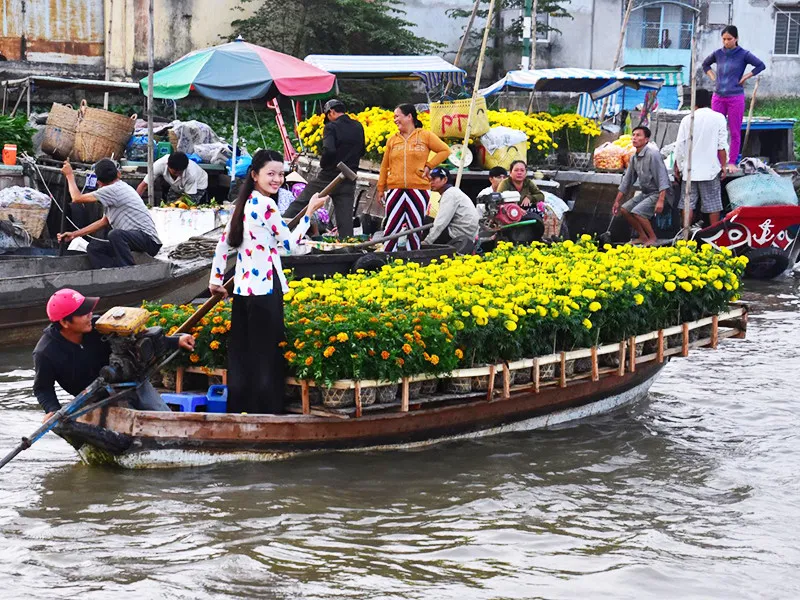The Mekong Delta, with its intricate network of rivers and canals, has long been a captivating destination for travelers, drawn by its lush natural beauty and unique culture. Among its highlights, the Mekong Delta floating markets stand out as a distinctive cultural feature, deeply rooted in the identity of the Mekong Delta region. Visiting these markets offers more than just a shopping experience on the water; it’s a chance to immerse yourself in the vibrant culinary culture and unique way of life of the local people. This article provides the most detailed guide to visiting the floating markets of the Mekong Delta, ensuring you have a fulfilling and memorable journey of discovery.
Mekong Delta Floating Markets – A Unique Water Culture
Floating markets in the Mekong Delta are not merely trading hubs; they are an integral part of the cultural tapestry of the people in the Mekong Delta. Originating from the need to exchange goods when road transport was underdeveloped, these markets have evolved into a unique cultural attraction, drawing both domestic and international tourists.
History and Development of Floating Markets
In the past, when road systems were limited, waterways became the primary transportation routes for people in the Mekong Delta. Floating markets naturally emerged to meet the trading needs of riverside communities. Initially, they were simple meeting points on the river where people gathered to exchange agricultural products and goods. Over time, these markets grew, becoming economic and cultural centers for the entire region.
Today, despite the development of road networks, floating markets remain vital to the economic and cultural life of the Mekong Delta. More than just places of commerce, they are social hubs, venues for cultural exchange, and the most vivid expression of the region’s unique riverine character.
Unique Characteristics of Mekong Delta Floating Markets
Mekong Delta floating markets possess distinct features that set them apart:
- Unique “Advertising Poles”: Instead of signs, vendors in floating markets use “advertising poles” to promote their goods. Each boat displays samples of what they sell on a tall bamboo pole. For example, if they sell sweet potatoes, they hang sweet potatoes; if they sell watermelons, they hang watermelons. This advertising method is both unique and easily recognizable from a distance.
- “Mobile Homes” on the River: Boats are not just means of transport but also “mobile homes” for many merchant families. They live, trade, and spend their entire lives connected to the floating market.
- Diverse Goods: Mekong Delta floating markets offer a wide variety of goods, from agricultural products, food, and household items to clothing and fabrics. They are especially famous for fresh fruits, a specialty of the Mekong Delta.
- Vibrant Cultural Space: Floating markets are not just for buying and selling; they are vibrant cultural spaces where visitors can truly experience the rhythm of life and culture of the Mekong Delta people. The sounds of laughter, boat engines, and vendors’ calls all blend together to create a unique atmosphere.
- Rich Cuisine: When visiting a floating market, you cannot miss the opportunity to savor the distinctive local cuisine. From rustic breakfast dishes like hu tieu (rice noodle soup), bun rieu (crab noodle soup), banh canh (thick noodle soup) to fresh tropical fruits, everything carries the unique flavors of the Mekong Delta.
Exploring Famous Floating Markets in the Mekong Delta
The Mekong Delta is home to many floating markets, both large and small, each with its own unique charm. Here are some of the most famous markets you shouldn’t miss on your Mekong Delta journey:
1. Cai Rang Floating Market – Can Tho
Cai Rang Floating Market is one of the largest and most famous in the Mekong Delta, located on the Cai Rang River, about 6km from downtown Can Tho by road and 30 minutes by boat. The market typically starts very early, around 3-4 AM, and lasts until 8-9 AM.

Highlights:
- Largest Scale: Cai Rang Floating Market is renowned as the largest floating market in the Mekong Delta. Hundreds of boats from all over converge here to trade, creating a bustling and lively scene.
- Diverse Goods: Cai Rang Market trades in a wide range of goods, especially fruits, agricultural products, food, and household items.
- Distinctive “Advertising Poles”: At Cai Rang Market, you’ll easily see tall “advertising poles” with various agricultural products and fruits hanging from them, a unique feature of the market.
- Floating Market Cuisine: At Cai Rang Floating Market, you can enjoy many Mekong Delta specialties like hu tieu, bun rieu, banh canh, coffee, and more, right on mobile food boats.
Visiting Tips:
- Ideal Time: Visit Cai Rang Market early in the morning (around 5-7 AM) to best experience the bustling atmosphere of the market.
- Transportation: Hire a boat or ferry at Ninh Kieu Wharf or other tourist spots in Can Tho to reach the market.
- Experiences: Take a boat ride weaving through the boats, enjoy floating market cuisine, and buy local fruits and specialties.
2. Phong Dien Floating Market – Can Tho
Phong Dien Floating Market is located on the Can Tho River, about 20km from downtown Can Tho. Phong Dien Market has a more peaceful, rustic beauty compared to Cai Rang Market. It usually opens later, around 5-6 AM, and lasts until noon.

Highlights:
- Rustic Beauty: Phong Dien Market exudes a rustic, simple, and rural charm. The market atmosphere is quieter and less bustling than Cai Rang Market.
- Local Products: Phong Dien Market mainly focuses on local products such as vegetables, fruits, and agricultural goods from the Phong Dien region.
- Friendly Atmosphere: Vendors at Phong Dien Market are very friendly and hospitable. Visitors can easily chat with them and learn about their lives and culture.
- Green Canals: The journey to Phong Dien Market passes through lush green canals and orchards, creating a beautiful natural landscape.
Visiting Tips:
- Ideal Time: Visit Phong Dien Market in the morning (around 6-8 AM) to appreciate its peaceful beauty.
- Transportation: Hire a motorbike, car, or boat from downtown Can Tho to reach the market.
- Experiences: Take a boat trip along the canals, explore the floating market, enjoy local fruits and specialties, and visit riverside orchards.
3. Nga Nam Floating Market – Soc Trang
Nga Nam Floating Market is located in Nga Nam town, Soc Trang province, serving as a trading hub for five river branches: Can Tho, Vinh Quoi, Long My, Thanh Tri, and Phung Hiep. Nga Nam Market opens the earliest and closes the latest compared to other floating markets in the Mekong Delta.

Highlights:
- Unique Geographic Location: Nga Nam Market is situated at the intersection of five river branches, making it a crucial trading point for the entire region.
- Special Market Hours: Nga Nam Market operates from very early, around 2-3 AM, until late afternoon. Visitors can experience the market atmosphere at any time of day.
- Diverse Culture: Nga Nam Market is a melting pot of Kinh, Khmer, and Hoa cultures. Visitors can experience this cultural diversity in the cuisine, clothing, and customs of the local people.
- Agricultural Wholesale Market: Nga Nam Market is one of the largest agricultural wholesale markets in the Mekong Delta. Goods here are transported throughout the province and beyond.
Visiting Tips:
- Ideal Time: You can visit Nga Nam Market at any time of day, but early morning and late afternoon are the busiest times.
- Transportation: Take a bus or motorbike from Soc Trang city to Nga Nam town, then hire a boat to explore the floating market.
- Experiences: Take a boat to explore the market, enjoy local cuisine, and learn about the culture and life of the local people.
4. Other Floating Markets
Besides the famous markets mentioned above, the Mekong Delta also has many other floating markets worth exploring, such as:
- Tra On Floating Market (Vinh Long): Famous for delicious fruits and a peaceful rural market atmosphere.
- Cai Be Floating Market (Tien Giang): A long-standing market with over a century of history, famous for fruits and handicrafts.
- Long Xuyen Floating Market (An Giang): The second largest floating market in the Mekong Delta after Cai Rang, renowned for freshwater fish and fresh seafood.
Tips for Visiting Mekong Delta Floating Markets
To have a complete and memorable visit to Mekong Delta floating markets, keep these tips in mind:
- Ideal Time to Visit: The dry season (from December to April of the following year) is the best time to visit Mekong Delta floating markets. The weather is dry, with little rain, making it ideal for travel and sightseeing.
- Attire: Choose comfortable, neat, and easy-to-move clothing. Bring a hat, sunglasses, and sunscreen to protect your skin from the sun.
- Cash: Bring enough cash for shopping and expenses at the floating market, as not all places accept card payments.
- Ask for Prices Before Buying: Always ask for the price before buying anything at the floating market to avoid overpaying.
- Maintain Cleanliness: Floating markets are public spaces, so please maintain general hygiene and avoid littering in the river.
- Safety: Be mindful of safety when moving on boats, especially with children.
Conclusion
Mekong Delta floating markets are a must-visit destination when traveling to the Mekong Delta. With their unique cultural features, vibrant atmosphere, and rich cuisine, floating markets promise to offer visitors unforgettable experiences. We hope this detailed guide to visiting the floating markets of the Mekong Delta will help you have a fulfilling and meaningful journey exploring the Mekong Delta. Come and experience the bustling rhythm of life, unique culture, and hospitality of the people of this river region!